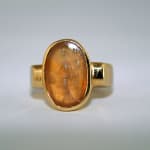Roman Intaglio depicting the Goddess Fortuna, 1 CE - 300 CE
Carnelian-Gold
FJ.6407
This intaglio is set in an 18 karat gold ring The art of glyptics, or carving on colored precious stones, is probably one of the oldest known to humanity. Intaglios,...
This intaglio is set in an 18 karat gold ring
The art of glyptics, or carving on colored precious stones, is probably one of the oldest known to humanity. Intaglios, gems with an incised design, were made as early as the fourth and third millennia BC in Mesopotamia and the Aegean Islands. They display a virtuosity of execution that suggests an old and stable tradition rooted in the earliest centuries. The tools required for carving gems were simple: a wheel with a belt-drive and a set of drills. Abrasives were necessary since the minerals used were too hard for a "metal edge. A special difficulty of engraving intaglios, aside from their miniature size, was that the master had to work with a mirror-image in mind.
Members of the imperial family, court officials, courtiers and the wealthy aristocracy of ancient Rome loved to wear lavish jewelry in the form of necklaces, bracelets and rings. Fortuna (Greek Tyche, goddess of wealth) was an obvious favorite among this elite group of people. Many cities of the Greek empire often portrayed Tyche on their coinage. During the Imperial period emperors had their personal Fortunas; and we might well imagine the image they had in mind matched that of the lovely goddess on this intaglio. She is seen here holding her famous cornucopia and a wreath. Her body is finely engraved and very graceful, her c1othes fold elegantly around her. She bas the relaxed appearance of someone not worried about monetary concerns, knowing her horn of plenty is eternally full.
The art of glyptics, or carving on colored precious stones, is probably one of the oldest known to humanity. Intaglios, gems with an incised design, were made as early as the fourth and third millennia BC in Mesopotamia and the Aegean Islands. They display a virtuosity of execution that suggests an old and stable tradition rooted in the earliest centuries. The tools required for carving gems were simple: a wheel with a belt-drive and a set of drills. Abrasives were necessary since the minerals used were too hard for a "metal edge. A special difficulty of engraving intaglios, aside from their miniature size, was that the master had to work with a mirror-image in mind.
Members of the imperial family, court officials, courtiers and the wealthy aristocracy of ancient Rome loved to wear lavish jewelry in the form of necklaces, bracelets and rings. Fortuna (Greek Tyche, goddess of wealth) was an obvious favorite among this elite group of people. Many cities of the Greek empire often portrayed Tyche on their coinage. During the Imperial period emperors had their personal Fortunas; and we might well imagine the image they had in mind matched that of the lovely goddess on this intaglio. She is seen here holding her famous cornucopia and a wreath. Her body is finely engraved and very graceful, her c1othes fold elegantly around her. She bas the relaxed appearance of someone not worried about monetary concerns, knowing her horn of plenty is eternally full.



